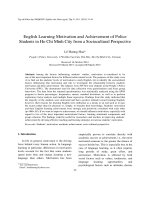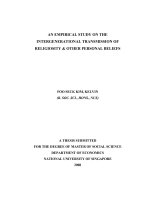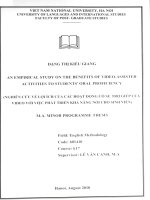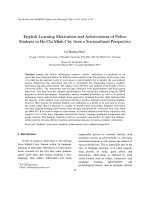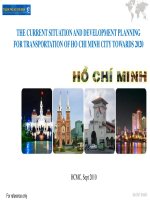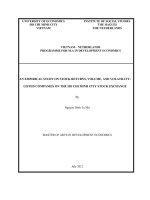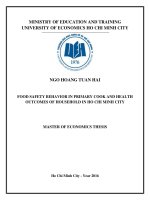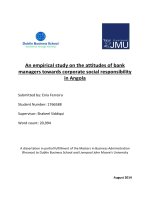An empirical study on stock returns, volume, and volatility listed companies on the ho chi minh city stock exchange
Bạn đang xem bản rút gọn của tài liệu. Xem và tải ngay bản đầy đủ của tài liệu tại đây (2.21 MB, 67 trang )
UNIVERSITY OF ECONOMICS
INSTITUTE OF SOCIAL STUDIES
HO CHI MINH CITY
THEHAGUES
VIETNAM
THE NETHERLANDS
VIETNAM- NETHERLANDS
PROGRAMME FOR M.A IN DEVELOPMENT ECONOMICS
AN EMPIRICAL STUDY ON STOCK RETURNS,
VOLUME, AND VOLATILITY: LISTED COMPANIES
ON THE HO CHI MINH CITY STOCK EXCHANGE
By
NGUYEN DINH TU NHI
Academic Supervisor
Dr. LE VAN CHON
MASTER OF ARTS IN DEVELOPMENT ECONOMICS
HO CHI MINH CITY, JULY 2012
UNIVERSITY OF ECONOMICS
INSTITUTE OF SOCIAL STUDIES
HO CHI MINH CITY
THEHAGUES
VIETNAM
THE NETHERLANDS
VIETNAM- NETHERLANDS
PROGRAMME FOR M.A IN DEVELOPMENT ECONOMICS
AN EMPIRICAL STUDY ON STOCK RETURNS,
VOLUME, AND VOLATILITY: LISTED COMPANIES
ON THE HO CHI MINH CITY STOCK EXCHANGE
By
NGUYEN DINH TU NHI
MASTER OF ARTS IN DEVELOPMENT ECONOMICS
HO CHI MINH CITY, JULY 2012
"
UNIVERSITY OF ECONOMICS
INSTITUTE OF SOCIAL STUDIES
HO CHI MINH CITY
THEHAGUES
VIETNAM
THE NETHERLANDS
VIETNAM- NETHERLANDS
PROGRAMME FOR M.A IN DEVELOPMENT ECONOMICS
AN EMPIRICAL STUDY ON STOCK RETURNS,
VOLUME, AND VOLATILITY: LISTED COMPANIES
ON THE HO CHI MINH CITY STOCK EXCHANGE
A thesis submitted in partial fulfillment of the requirements for the degree of
MASTER OF ARTS IN DEVELOPMENT ECONOMICS
By
NGUYEN DINH TU NHI
Academic Supervisor
Dr. LE VAN CHON
HO CHI MINH CITY, July 2012
ACKNOWLEDGEMENTS
I am not able to finish this thesis without the guidance of my supervisors and
committee members, supports from classmates, and aids from my family.
I would like to express my very great appreciation to my supervisors, Dr. Le
Van Chon and Dr. Truong Tan Thanh, for their patient guidance, enthusiastic
assistance, and useful critiques, valuable and constructive suggestions during my
research. I am also particularly grateful for the assistance given by Dr. Nguyen Trong
Hoai and Dr. Pham Khanh Nam for motivating and supporting me to complete the
thesis. I would like to offer another thank to Dr. Duong Nhu Hung, who inspires me to
choose this topic for my thesis. My grateful thanks are also extended to staffs of the
Administration Department and Library of Vietnam-Netherlands Programme in
providing me good environment and facilities to complete the thesis.
Finally, I would like to express my love and gratitude to my family and friends
for their understanding, supports, and encouragements throughout the research.
ABBREVIATIONS
ARCH
Autoregressive Conditional Heteroskedasticity
ARMA
Autoregressive Moving Average
EGARCH
Exponential Generalized Autoregressive Conditional Heteroskedasticity
GARCH
Generalized Autoregressive Conditional Heteroskedasticity
HNX
Hanoi Stock Exchange
HOSE
Ho Chi Minh City Stock Exchange
IGARCH
Integrated Generalized Autoregressive Conditional Heteroskedasticity
KSE
Karachi Stock Exchange
NASDAQ
National Association of Securities Dealers Automated Quotations
NGARCH
Nonlinear Generalized Autoregressive Conditional Heteroskedasticity
NSE
National Stock Exchange
NYSE
New York Stock Exchange
QGARCH
Quadratic Generalized Autoregressive Conditional Heteroskedasticity
SEM
Stock Exchange of Mauritius
SENDEX
Sensitive Index
S&P
Standard & Poor's
TGARCH
Threshold Generalized Autoregressive Conditional Heteroskedasticity
us
United States
VAR
Vector Auto Regression
VN-Index
Vietnam Stock Market Index
TABLE OF CONTENTS
CHAPTER 1:
INTRODUCTION ................................................................................. !
1.1. Problem statement ......................................................................................................... 1
1.2. Research questions ........................................................................................................ 3
1.3. Research objectives ....................................................................................................... 3
CHAPTER 2:
LITERATURE REVIEW ..................................................................... 5
2.1. The Efficient Market Hypothesis .................................................................................. 5
2.2. The Mixture of Distributions Hypothesis ..................................................................... 7
2.3. The Sequential Information Arrival Hypothesis ........................................................... 9
2.4. The Generalized Autoregressive Conditional Heteroskedasticity .............................. 10
2.5. Conceptual framework ................................................................................................ 13
CHAPTER 3: VIETNAMESE STOCK MARKET AND LISTED COMPANIES
ON THE HO CHI MINH CITY STOCK EXCHANGE .............................................. 14
3 .1. Vietnamese stock market ............................................................................................ 14
3.2. Data ............................................................................................................................. 16
3.3. Summary statistics ...................................................................................................... 21
3.4. Graphical analysis ....................................................................................................... 24
CHAPTER 4:
ECONOMETRIC MODELS AND DISCUSSION .......................... 26
4.1. Test for stationarity in stock return and trading volume: ............................................ 26
4.2. Trading volume and return volatility .......................................................................... 33
CHAPTER 5:
CONCLUSIONS .................................................................................. 46
5 .1. Conclusions ................................................................................................................. 46
5.2. Policy implications ...................................................................................................... 47
5.3. Limitations and next findings .................................................................................... .48
REFERENCE ................................................................................................................... 49
LIST OF TABLES
TABLE
PAGE
1. Table 3.1 Some numbers in 2012 ................................................ .15
2. Table 3.2 Description ofstocks ................................................... 16
3. Table 3.3 Descriptive statistics ................................................... 21
4. Table 4.1 ADF test .................................................................. 26
5. Table 4.2 PP test .................................................................... 30
6. Table 4.3 GARCH (1,1) model without LnVol. ................................ 36
7. Table 4.4 Likelihood ratios of stocks ............................................. 39
8. Table 4.5 GARCH (1,1) model with LnVol. .................................... .41
LIST OF FIGURES
FIGURES
PAGE
1. Figure 2.1 Conceptualized relationships among variables ..................... 13
2. Figure 3.2 Graphs of return, percentage of trading volume, percentage of foreign
buying volume, and percentage of foreign selling volume for 8 listed
stocks .................................................................................. 24
ABSTRACT
AN EMPIRICAL STUDY ON STOCK RETURNS, VOLUME, AND
VOLATILITY- LISTED COMPANIES ON THE HO CHI MINH CITY STOCK
EXCHANGE
By
Nguyen Dinh Tu Nhi
The thesis examines the relationship between stock returns, trading volume and return
volatility. With the focus on listed companies on the Ho Chi Minh City Stock
Exchange over the period between 01 Jan 2007 and 31 Dec 2011, the study conducts
GARCH ( 1, 1) to model the relationship between stock return, trading volume, and
volatility. I also include a dummy to capture possible effect of pre and post-crisis on
stock return volatility. The analysis results show that there exists an influence of
trading volume on stock return, even after controlling effects of foreign trading
volume. It is also evident that trading volume has some predictive power to return
volatility. I also find our results consistent with previous studies such as Clark ( 1973)
and Copeland (1976). The result also implies that Vietnamese stock market is
efficiently weak at least for listed companies on the Ho Chi Minh City Stock
Exchange.
Key words: Trading volume, stock returns, return volatility, foreign trading, GARCH.
CHAPTER 1:
1.1.
INTRODUCTION
Problem statement
In each country, the stock market reflects the health of its economy. It does not
only affect foreign exchange and gold markets but also credit market and option
market. Actually, when a stock market is strong, the investors often tend to convert
foreign currency and gold into cash to invest in stocks. It will depreciate foreign
currency and gold consistently and vice versa. In other hands, in term of weak stock
market, the Government will tighten cash flow for stocks as well as the bai1ks will
reduce disbursement for stocks and vice versa. For option market, the strong stock
market will lead to growth of different kinds of options because investors expect to
earn more profits.
In Vietnam, the stock market also plays an important role to mirror the changing
economy. For instance, when the information of bad debts or higher inflation is
proclaimed, the VN-index will decrease sharply. Likewise, when the Government
introduces some supporting policies to the economy, the VN-index has a chance to
increase. The fluctuation of VN-index also indicates a development or recession of
economy. That is called bi-directional effect of information and stock market.
In the mean-variance analysis, the expected stock returns and return volatility
are important factors that investors concentrate on because returns and volatility imply
risks for investors' portfolio. Moreover, the volume of trade is also supposed to be an
authoritative component of absorbing information in the stock market. In case investors
believe in higher return on stocks, they tend to deal more and lead to higher trading
volume in the stock market. In contrast, when they forecast lower return on stocks, they
will trade less or the trading volume will decrease. Hence, the higher or lower trading
volume may be a signal of the fluctuations of stock returns.
As a result, the relationships among stock returns, trading volume and return
volatility have become vital topics in empirical researches. There are many papers on
return-volume and volume-volatility relationships. For the return-volume relationship,
Karpoff (1987) finds the positive asymmetric relationship between volume and price
change in the equity market. Another model which also predicts the asymmetric
relationship between trading volume and price changes is initiated by Epps (1975) and
complemented by Jennings, Starks, and Fellingham (1981). Two above models relates
to flow of information. Furthermore, Granger, Morgenstern, and Godfrey (1964) and
Granger (1968) use data of indices and individual stocks on the New York Stock
Exchange to test the relationship between price changes and trading volume. They find
that price changes follow a random walk in which the past trend of stock price cannot
predict its future trend. Mohammadreza Mehrabanpoor, Babak Valizadeh Bahador, and
Gholamreza Jandaghi (2005) also get the positive relationship between market turnover
and indices on the Tehran Stock Exchange. In addition, Michael Long (2007) finds a
significantly positive interaction between absolute value of call price changes and
trading volume in the option markets.
For the volume-return volatility relationship, Engle (1982) originates the
Autoregressive Conditional Heteroskedasticity (ARCH) Model, which enumerates that
stock returns follow a mixture of distribution. Later, Bollerslev (1986) starts the
Generalized Autoregressive Conditional Heteroskedasticity (GARCH) Model and
consider trading volume as a proxy of information flow. Thus, the model is developed
by Lamoureux and Lastrapes (1990), Brailsford (1996), Mestel, and Gurgul and
Majdosz (2003). Moreover, Timothy J. Brailsford (1996) contends that the relationship
between stock return volatility and volume is positive through GARCH model.
However, some present opposite views. A. Fujihara and Mbodja Mougoue (1997) fmd
that there is no causal relationship between return and volume. According to Roland
Mestel, Henryk Gurgul, and Pawel Majdosz (2003), the relationship between stock
return and trading volume is too weak to forecast each other. Bema Okan, Onur Olgun,
and Sefa Takmaz (2009) conclude that trading volume has negative effect on return
2
volatility by applying GARCH, EGARCH, and V AR models. For the Vietnamese
market, Truong Dong Loc (2009) investigates the unilateral causality effect of HNXindex to trading volume. Furthermore, Truong Dong Loc and Dang Thi Thuy Duong
(20 11) replicate the study with the data of foreign trading volume, and find that the
index influences net foreign volume, but the reverse is not true.
There are only few researches that has examined relationship between stock
returns and trading volume during the recent crisis, and accounted for effect of foreign
trading volume across different industries using GARCH model. This thesis attempts to
fill this gap by examining the relationship between trading volume and stock return and
between return and volatility for listed companies on the Ho Chi Minh City Stock
Exchange. Particularly, I test the effect of trading volume on stock return and return
volatility by applying GARCH ( 1, 1) model.
1.2.
Research questions
To clarify the relationships among trading volume, stock returns and return
volatility, I collect data series of intra-day stock prices to test the appropriate model.
The final purpose is that, in this paper, I am going to answer the following research
questions:
(i)
Is there the relationship between trading volume and return volatility? and
(ii)
Does trading volume cause stock returns?
1.3.
Research objectives
To reach above aims, my objectives of the paper are:
(1) To examine the relationship between trading volume and return volatility and,
(2) To understand the impact of trading volume on stock return through GARCH (1,1)
model.
To that end, I use data of eight listed companies on the Ho Chi Minh City Stock
3
Exchange (HOSE) before and after the recession triggered by the US sub-prime
mortgage crisis.
The remainder of the paper is arranged as follows. Chapter Two gives a brief
literature review of empirical studies. Chapter three presents description of Vietnamese
stock market and explains specific characteristics of data. This chapter also exposes
statistics of selected stocks in the HOSE. The methodology and discussion of empirical
results are in chapter four which is followed by Conclusion.
4
CHAPTER2:
LITERATURE REVIEW
There are many empirical studies on relationships among trading volume, stock returns
and return volatility. At the outset, the Efficient Market Hypothesis is important for
stock markets; however, it also contains some controversies. Hence, the Mixture of
Distribution and the Sequential Information Arrival Hypotheses are introduced to
supplement the Efficient Market Hypothesis. Finally, the Generalized Autoregressive
Conditional Heteroskedasticity is proposed depending on the Mixture of Distribution
Hypothesis and the Sequential Information Arrival Hypothesis.
2.1.
The Efficient Market Hypothesis
The Efficient Market Hypothesis (EMH) is one of important theories for
financial series data. The EMH is introduced by Fama (1970) and widely admitted by
modem economists. They think that the financial market is extremely efficient to
reflect information about individual stocks and the stock market. The EMH
hypothesizes that stock prices are able to reflect all available information so that they
mirror all credence of investors about the future. Under the EMH, the flow of
information integrates with prices of stock promptly and efficiently at any point in
time, therefore, the current stock price is not used to forecast movements of price
hereafter.
Based on the availability of information, Keith and Dirk (2005) recommend
three versions of the EMH, including weak, semi-strong, and strong forms. In the
weak-form efficiency, stock prices merely reflect all public available information in the
past. The stock prices are the most easily public accessible information in the stock
markets.
In the semi-strong form efficiency, the stocks prices reflect not only all available
public information but also new public information immediately. The available public
information compromises both past prices and relevant information, such as: claimed
5
financial statements, announcements of dividends and profits, share splits, merge and
acquisitions, influence of macroeconomics (inflation, interest rate, exchange rate, so
on), and vice versa. Under the semi-strong form, the current market price is the best
predictor of a fair stock price. Thus, both above hypotheses claim that no one can earn
by trading on the information that other investors have comprehended. However, the
semi-strong form is stronger than weak form.
Increasingly, in the strong form efficiency, the current stock prices reflect both
private and public information for companies which is incorporated with market prices
quickly.
Hence, no investors can find under-valued stocks consistently or inside
traders are not able to take any advantages. In this form, the current market price is the
best forecaster of a fair price.
There are many researches supporting the market efficiency broadly. Thomas E.
Copeland and Daniel Friedman (1987) observe variables of price behavior, trading
volume, and portfolio composition in response to information arrival on the National
Association of Securities Dealers Automated Quotations (NASDAQ). They compare
the price, volume, and allocations of shares in three market equilibrium models:
telepathic rational expectations, ordinary rational expectations and private information.
Finally, they fmd that stronger form of market forecasts equilibrium prices better than
weaker one.
Maloney and Mulherin (2003) study velocity and precision of price through
relationship between stock returns and trading volume in the crash of space shuttle
challenger for four firms. They find that price movement happens even in a trading
hitch to resolve faults or with low trading profits. They are not capable to discover real
manner so that the informed traders can provoke price movement.
While Fama (1970) and above researchers dominates the EMH, there are some
controversial researches in the market efficiency. For instance, Sanford J. Grossman
and Joseph E. Stiglitz (1980) attribute that an informational efficiency is impossible.
6
Stock prices cannot mirror the available information absolutely since the information is
expensive. In case of perfectly informational market, the investors will not profit to get
information and make any analysis on it. LeRoy and Porter (1981) fail to accept the
market efficiency because of excess volatility of stock markets. Marsh and Merton
(1986) also reject the EMI-L Furthermore, Lawrence H. Summers (1986) examines the
statistical tests to valuate efficiency of speculative stock market. He observes that the
speculation seems to plague the rational valuation as well as efficiency of the market.
In 1990, Laffont and Maskin fail to accept the EMH in case of imperfect competition
and Jegadeesh rejects the random walk hypothesis 1 with strong evidence of
predictability of stock returns. Recently, Lee et al. (2010) have purported that stock
market is not efficient in term of stationarity of stock prices.
For these reasons, some more rational theories are ascribed. Karpoff (1987)
brings the most important study from results of many previous studies in various
markets. He makes a survey to examine the relationship between price changes and
trading volume. He assorts his studies into two parts: testing the relationship between
absolute price changes and trading volume as well as examining the relationship
between price changes and trading volume. He revises empirical studies on those
relationships and finds out the positive relationship between volume and price change
in equity market. Lastly, he also debates that there may exist asymmetric relationship
between price change and volume although a number of researchers use linear models
to investigate this relationship. His effort is necessary to explain the Mixture of
Distribution Hypothesis (Clark, 1973) and the Sequential Information Arrival
Hypothesis (Copeland, 1976).
2.2.
The Mixture of Distributions Hypothesis
The Mixture of distributions hypothesis is initially proposed by Clark (1973).
1
Random Walk Hypothesis: is consistent with the Efficient Market Hypothesis
7
According to Clark (1973), the price changes and trading volume are influenced by
same information flow so that volume and volatility are correlated. Meanwhile, the
variable of return volatility is the total of random number of intra-day return volatility.
In the MDH model, the trading volume is considered a proxy for the rate of
information flow and is used to valuate stock returns by new information flow. It
explains that returns and volume will alter simultaneously so as to response to arrival
of new information. It also states that stock prices and trading volume are positively
correlated since variance of stock price on a transaction depends on its trading volume.
The MDH is developed by Epps and Epps (1976), Tauchen and Pitts (1983),
Lamoureux and Lastrapes (1990), and Andersen (1996). Epps and Epps (1976) argue
that the change of logarithm of price can follow a mixture of distribution and trading
volume can be a mixing variable. Andersen ( 1996) supplements trading volume into
the hypothesis which is uncorrelated to flow of information. Volume is a result of
trading on noise or liquidity which is opposite to trading on the arrival of information.
Unlike Tauchen and Pitts (1983) suppose an i.i.d. 2 arrival process of information,
Andersen (1996) implies that the rate of information arrival has been correlated
serially. That is, the lagged volumes and volatilities are positively correlated with
current volatilities and volumes.
Chen and Tse (1993), Omran and McKenzie (2000), Zarraga (2003), Pyun et al.
(2000), and Bohl and Henke (2003) find supportive evidence from Japanese, UK,
Spanish, Korean, and Polish stock markets, respectively.
Ali Ahmed, Hassan, and Nasir (2005) test the volatility of Kuala Lumpur Stock
Exchanges by the Mixture of Distribution Hypothesis. The paper implements the
GARCH model to imply that the return volatility is analyzed best by GARCH ( 1, 1)
model. They also add trading volume as explanatory variable in the model to find that
2
i.i.d. means independent and identically distributed
8
-----
the volatility persistence unchanged in case of inclusion of volume.
However, the MDH is criticized by some evidences. Firstly, it does not stipulate
volatility on volume. Hence, it fails to show volatility persistence after adding trading
volume as explanatory variable. Secondly, Fong (2003) and Xu et al. (2006) prove that
the MDH does not condition serial dependence on return volatility and volume.
Furthermore, Nowbutsing and Naregadu (2009) employ thirty six stocks, six
constructed indices and the Stock Exchange of Mauritius (SEM) Index to test the
relationships between trading volume and return and between volume and volatility.
The paper uses ARCH-in-mean model and finds that the relationship between trading
volume and volatility is weakly positive. Therefore, the study has not supported the
MDH and SIAH on the SEM.
Kumar, Singh, and Pandey (2009) use data of 50 Indian stocks to investigate the
relationship between price and trading volume. They apply the GARCH model to test
the relationship between the conditional volatility and trading volume. Their findings
indicate that there is a positive asymmetric relationship between volume and
unconditional volatility exists. However, under the MDH, the results are mixed
because they do not decline the MDH perfectly but do not support it unconditionally.
2.3.
The Sequential Information Arrival Hypothesis
On the contrary, the Sequential Information Arrival Hypothesis (SIAH) induces
different argument from the MDH. The SIAH is originally introduced by Copeland
(1976) and argued more by Jennings et al. (1981). It supposes that the arrival of new
information is diffused to informed and uninformed traders sequentially. In the SIAH,
the market participants do not response to new information contemporarily, but
sequentially. Hence, the informed investors who absorb the information flow first
could take advantages and control their portfolios accordingly. The sequential
information flow has driven a positive bi-directional causality relationship between
absolute value of returns and trading volume since the lagged absolute returns are able
9
to predict current trading volume and vice versa. Later, Jennings et al. (1981) develops
the theory. Moreover, by using stock prices and trading volume in the NYSE, Harris
(1987) and Smirlock and Starks (1988) report positive interaction between volume
changes and prices. To support the SIAH, Hiemstra and Jones (1994) contend that a
flow of sequential information enables lagged trading volume to predict current
absolute returns (price changes) and enables lagged absolute returns to predict current
trading volume.
Both the MDH and SIAH attempt to explain the positive relationship between
volume and price changes. However, whereas the MDH implies a contemporaneous
relationship between price changes and trading volume, the SIAH proposes a
sequential dynamic relationship between returns and volume in which lagged price
change can forecast current trading volume and vice versa (Darrat et al., 2003).
2.4.
The Generalized Autoregressive Conditional Heteroskedasticity
Under the MDH and SIAH theories, many recent studies propose several
models in the relationship between price and volatility accordingly. Engle (1982)
presents the Autoregressive Conditional Heteroskedasticity (ARCH) Model depending
on the theory that the time series of stock return are not derived from single distribution
but mixture of distribution to create expected return. The ARCH model is appropriate
for financial data, especially time series data. In the ARCH model, the arrival of
information is the stochastic mixing variable whereas daily return is a mixture of
distribution.
Afterward, Bollerslev (1986) proposes the Generalized Autoregressive
Conditional Heteroskedasticity (GARCH) model. Both ARCH and GARCH models
are able to deal with heteroskedasticity of time series because they can measure the
volatility of portfolio, analyze portfolio and price assets. The GARCH model uses
trading volume as a proxy of flow of information in the market to analyze market
volatility.
10
The model is developed by Lamoureux and Lastrapes (1990), Brailsford (1996)
and Mestel, Gurgul and Majdosz (2003). The important implication of this model is to
limit the conditional variance of time series and to rely on past squared residuals on the
process. For example, Lamoureux and Lastrapes (1990) use daily trading volume as an
explanatory variable to explain the volume-return volatility relationship for active
stocks in the US. The results of mixed model connote that the variance of daily price is
heteroskedastic and relates to arrival of information positively. Moreover, they also
find that ARCH effect or persistence of volatility will diminish when the trading
volume is added into the conditional variance equation. In addition, they find that the
inclusion of lagged volume in the variance equation is insignificant for almost cases.
Najand and Yung (1991) use treasure bond futures to analyze as Lamoureux and
Lastrapes (1990) conduct. They report that the lagged volume explains volatility better
than contemporaneous volume.
Furthermore, Brailsford ( 1996) advocates that the relationship between price
changes and volume is positive through three measures of trading volume. He selects
top eight stocks in the Australian Stock Market ranked by market capitalization. He
applies the conditional variance equation of GARCH model to examine the relationship
between volume and stock market volatility. The result proves that the slope of volume
and volatility for negative returns is less than slope for positive returns. Therefore, it
supplements asymmetric relationship. When trading volume is considered as an
exogenous variable, the GARCH coefficient reduces their significance and magnitude,
respectively. The paper is an initial analysis of volume and price change relationship
which will accelerate more works in the future.
According to Mestel, Gurgul, and Majdosz (2003), the contemporaneous and
dynamic relationship between stock return and trading volume is weak, meaning they
cannot forecast each other. Meanwhile, the relationship between return volatility and
trading volume is strong, meaning the volatility predicts volume in some cases.
11
Khan and Rizwan (2008) examine the relationship between volumes and return
volatility by the GARCH (1, 1) model. They use data series of the Karachi Stock
Exchange (KSE-1 00 index) to indicate that a positive contemporaneous relationship
between volume and volatility exists after controlling heteroskesaticity.
Mahajan and Singh (2009) use daily data of the Sensitive Index (SEND EX) of
Bombay Stock Exchange- India's stock exchange- over the period of October 1996 to
March 2006 to test the relationship between return, volume and volatility. The
empirical results conduct positively significant interaction between volume and return
volatility based on both MDH and SIAH. Applying GARCH (1,1), the paper declines
the persistence of variance when including trading volume as a proxy of information
flow in the conditional volatility equation.
Singh and Mehta (20 10) attempt to investigate the relationship between trading
volume and stock return volatility in Asian stock. They also apply the GARCH (1,1)
model to analyze volatility and predict returns of individual stocks. They verify that the
parameters for all series in the return volatility equation are fully significant and the
impact of recession is obvious through figures.
Pati and Rajib (2010) use National Stock Exchange S&P CRISIL NSE Index
Nifty Index futures, and GARCH and ARMA-EGARCH models to analyze the
persistence of volatility. The findings indicate that the inclusion of trading volume into
GARCH model dampens the persistence of volatility. Yet, the GARCH effect entirely
does not disappear.
On the other hands, Chen et al. (200 1) report the opposite findings to
Lamoureux and Lastrapes (1990). They find that the volatility persistence is not
eliminated in case of including the contemporaneous trading volume in GARCH
model.
All in all, there are many and many empirical studies on relationship among
trading volume, stock returns and price changes. It can be positive or negative. It
12
always happens in both the developed and emerging markets day by day. However,
there are a few papers researching on impacts of foreign buying volume, foreign selling
volume, and pre and post-recession on GARCH (1,1) model on the Ho Chi Minh Stock
Exchange. As a result, I continue to study more on the relationship between volume
and returns and between volatility and volume on the data series of eight listed
companies on the Ho Chi Minh stock market.
2.5.
Conceptual framework
This paper focuses on the relationship between average returns and return
volatility which will act as the dependent variables and flows of information and
dummy variable which will act as the independent variables. The return is calculated
by daily closing prices of stock on two continuous day t-1 and t, whereas the
characteristics of flows of information include trading volume, foreign buying volume,
and foreign selling volume. The dummy variable presents pre and post December 2008
to study impacts of before and after recession on returns.
Figure 2.1: Conceptualized relationships among variables
Dependent variable
rl
Independent variables
The lagged return
Dependent variable
)
The trading volume
The mean
stock return
• Percentage of trading volume
• Percentage of foreign
buyinging volume
• Percentage of foreign sellinging
volume
.....
'-----!
The dummy variable
-
t-
1---.
The past return volatility
t-
The past value of squared of
error term (innovation term) r--13
The
conditional
return
volatility
CHAPTER3:
VIETNAMESE STOCK MARKET AND LISTED COMPANIES
ON THE HO CHI MINH CITY STOCK EXCHANGE
3.1.
Vietnamese stock market
There are many researches on Vietnamese stock market, both domestic and
foreign researchers. Vietnam opens and develops the economy from well-known "Doi
Moi" policy. Vietnam adjusts many things on policies to integrate with the globe and
gain high economic growth. Therefore, the growth rate of GDP in Vietnam is about 7
percent yearly over the past decade. The economic growth under the development of
finance is a certainty. As a result, Vietnamese stock market is born to meet requirement
of the economy (Vuong Thanh Long, 2008).
The stock market is born firstly in Ho Chi Minh City on July 2000 with merely
two listed stocks. In the first two years, stock trading occurs only in a few alternative
days. Over eight years later up to 2006, the Ho Chi Minh City Stock Exchange (HOSE)
jumps from 34 listed companies with market capitalization of 86 million dollars to 268
companies with more than 27 billion dollars of capitalization as well as 25,000 eligible
trading accounts for investors (from Financial Times produced by Ben Bland). On July
2010, HOSE has 24 7 listed companies with market capitalization of about 28.28 billion
dollars. Meanwhile, Hanoi Securities Trading Center (HASTC), which is established
by the Decision No. 12711998/QU-TTg dated July 11, 1998, is smaller than HOSE. In
2009, Hanoi stock exchange (HNX) is established by the Decision No. 0112009/QUTTg dated January 02, 2009 by the Prime Minister of Vietnam when restructuring
Hanoi Securities Trading Center.
According to statistical data, over the period of 2000- 2003, the stock market
grows from 98 points up to 571 points on June 2001 and down to 139 points on April
2003. Meanwhile, in the period 2004 - 2005, VN index moves up from 213 to 307
points. In the period of 2006 - 2009, VN index reaches remarkable point to the top of
14
1,167 points on Feb 2007. It is used to be unforgettable point of time for all investors.
The index falls sharply on Feb 2009 at 235 points and moves up to 480 on December
31, 2010 (Nguyen Thi Kim Yen, 2011).
The stock market has become larger and larger with new listed companies. In
2008, there are 164 companies listed on HOSE and 154 ones on HNX. The number of
listed companies increases up to 627 ones in the year 2010 including companies on
HOSE, on HNX, and fund management companies (Nguyen Thi Kim Yen, 2011).
Some summarized numbers of the year 20 10 as follow:
Table 3.1: Some numbers in 2010
Market capitalization (USD billion)
35
Average daily trading value (USD
80
million)
627
Listed securities
2.5%
Dividend yield
;;
Source: Bloomberg, 2010
For the Ho Chi Minh City Stock Exchange (HOSE), the Prime Minister signs
Decision No.559/2007/QD-TTg on May 11th, 2007 to alternate Ho Chi Minh Securities
Trading Center into Ho Chi Minh Stock Exchange. The stocks listing on Ho Chi Minh
Stock Exchange (HOSE) have to meet criteria as follows (on 31st December 2011):
The listing companies are joint stock companies with paid-up capital at the time
of registration for listing at least VND80 billion at book value.
Business operation in two years before the year of listing has to be profitable
and has no accumulated losses up to the year of registration for iisting.
15

